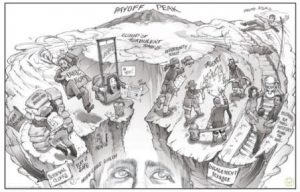Unlocking big data in commercial real estate
By partnering directly with data providers, firms can gain insights that allow them to dispel misconceptions and focus on the most promising opportunities.
BY CoStar
Strategists at a commercial real estate developer recently had a major “Aha!” moment: The markets they are targeting for new projects are precisely those where the competition is most intense, creating a dangerous risk of oversupply.
This insight was gleaned from a data-driven heatmap analysis that showed the intensity of new supply in a particular type and size range of a niche asset class across a dozen U.S. markets—at the granularity of individual buildings.
For years, the developer has focused on delivering new product in high-growth markets. But so are its competitors. As a result, those markets are at risk of becoming saturated with supply that outpaces demand. Armed with this knowledge, the developer is now considering a strategic shift toward markets with more favorable supply-demand dynamics.
“When a market heats up, and builders are going a thousand miles per hour, it’s often difficult for developers to step back and gain perspective on just how much supply is in the pipeline and its implications for the future value of their projects,” says Chad Littell, CoStar’s U.S. national director of capital markets analytics. “To gain this knowledge, they need to review granular, tailored market data at least monthly to synthesize the information into practical insights and present the takeaways in actionable visualizations.”
SUPPLY AND DEMAND: FINDING OPPORTUNITY
Leading real estate firms are learning the advantages of partnering directly with data providers to make this happen. Historically, owners and developers relied heavily on brokers to augment their in-house market insights. The typical result was broad-stroke insights for types of commercial real estate (retail, office, or industrial) and market locations (urban or suburban). Moreover, competing companies tended not to share their data with other market participants.

An industry shift is underway today, as macroeconomic volatility and extreme differentiation among sub-types of real estate and markets have created the need for data that is as specialized and current as possible. Companies should also see how trends have evolved over cycles to gain insight into the right timing for investments. “With tenant demand slowing and new supply peaking, developers need to pinpoint the opportunities to align supply and demand better,” says Littell.
Littell highlights retail space as a prime example of data’s value in challenging the prevailing market narrative. Ten years ago, many market participants assumed that e-commerce would doom brick-and-mortar stores, leading to an oversupply of retail buildings. Developers accepted the narrative and scaled back on retail projects. Instead, demand for retail space continued, leading to today’s record-low retail vacancy rates. “The vacancy rate for smaller freestanding retail space is around 2.5%, which is as low as possible,” says Littell. With real-time monitoring of supply and demand for specific types of retail properties in individual markets, developers could have capitalized on the contrarian opportunities.
ON FOOT, BY CAR, BY PLANE: GATHERING AND ANALYZING DATA AT ALL LEVELS
Gathering granular property-level data is, of course, quite challenging. “CoStar’s 1,500 researchers leverage their market relationships and monitor a wide variety of information sources, both public and private. They canvass the market on foot and in the car, photographing properties, verifying construction starts, and monitoring listings. From above, the research team captures drone imagery and leverages its exclusive CoStar plane to identify new construction, development status, and cases where a change of use is in progress,” says Littell. This dedicated team tracks more than seven million commercial properties globally.
“We integrate this constellation of data to tell a cohesive story. By analyzing data from the national level all the way down to the property level, you can best know which type of industrial building offers the most attractive development opportunity in a particular neighborhood. In this example, big box logistics centers may be overbuilt, but vacancies could be tight among mid-bay multi-tenant properties. So, saying all industrial is overbuilt in this submarket would be too broad a conclusion, and you might miss an opportunity,” says Littell. The company’s economists provide analyses and forecasts for 652 markets and just over 17,000 submarkets.
Data-collection efforts are aided by the real estate industry’s transition to a culture of data sharing. “It’s intuitive and comes naturally for this new generation of brokers and owners to share information,” says Littell. “As a result, the available data is getting more robust, and there are more categories and layers of data for property owners to utilize.”
After data is collected and analyzed, the next challenge is to present it to decision-makers in an actionable format that suits how they like to visualize data. “We provide raw data that are exportable to Excel, as well as interactive dashboards, charts, and tools that enable filtering and searching in real-time,” says Littell. For example, CoStar clients can easily create customized competitive property set surveys and quickly understand the long-term trends in absorption, vacancy, and asking rates among that unique set of properties. Additionally, deal-making tools like the lease analysis dashboard allow clients and their brokers to see how changing lease terms in a proposal—such as starting rent, escalations, free rent, and tenant improvements—affect the net present value of a lease. Parties in different locations can use the tool together in real-time to generate insights that inform their lease negotiations.
BROKERS STILL PLAY A CRITICAL ROLE
Even with these data-driven improvements, the human element remains essential in real estate. “Greater access to data and technological tools will be job creators,” says Littell. To capitalize on the opportunities, companies need experts, such as data analysts and data scientists, to fill roles that haven’t previously existed inside commercial real estate firms.
Companies with comprehensive data and analytics platforms also get value from brokers, to understand the past, present, and future of where market trends are heading. “Brokers will continue to play a vital role as consultants and strategic advisers to help owners and tenants navigate changes in the market,” says Littell. “By harnessing the power of big data through the lens of historical insights and forecasting tools and then marrying those interpretations with their broker’s market experience and foresight, firms can gain the most holistic picture of their markets.”
(11)
Report Post






